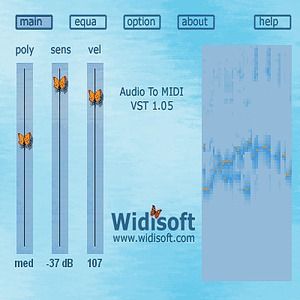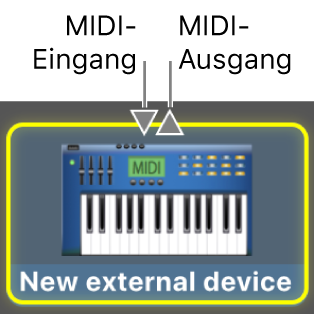Set up MIDI devices using Audio MIDI Setup on Mac View a MIDI configuration. In the Audio MIDI Setup app on your Mac, choose Window Show MIDI Studio. In the MIDI Studio. Create a MIDI configuration. In the Audio MIDI Setup app on your Mac, choose Window Show MIDI Studio. Audio MIDI Setup is the Mac OS X utility that allows you to set up audio and MIDI devices. This month we're going to delve into the MIDI Devices tab, in order to explain how applications work with the MIDI hardware you've connected to your Mac. The following sections introduce you to Mac expansion capabilities, audio and MIDI cabling, and other things you should consider when connecting audio and MIDI interfaces to your system. Computer Expansions. Depending on your Mac system, some or all of the following expansion capabilities are available, which can be used for audio and MIDI.

Audio MIDI Setup User Guide
If you use MIDI devices or a MIDI interface connected to your Mac, you can use Audio MIDI Setup to describe the configuration of your MIDI devices. There’s a default configuration already created, but you can set up your own.
You can use this configuration information for apps that work with MIDI, such as sequencers, to control your MIDI devices.
Note: Make sure your MIDI devices are connected to your Mac. If you’re using an interface device, connect any other MIDI devices you’re using to the interface. Also check that any software provided by the manufacturer of the MIDI devices has been installed. For more information, see the documentation that came with your devices.
View a MIDI configuration
In the Audio MIDI Setup app on your Mac, choose Window > Show MIDI Studio.
In the MIDI Studio window, click the Choose MIDI Configuration pop-up menu (it may show Default), then choose the configuration you want to view.
In the toolbar, click the following buttons to change how the configuration is shown:
Hierarchical View : Devices in the configuration are shown as icons. If a device isn’t connected, its icon is dimmed. To view information about a device, such as channel properties and ports, and to add or remove ports, double-click the device’s icon.
List View : Devices in the configuration are shown in a list, organized by type (such as Interface or External Device). If a device isn’t connected, it’s dimmed. To filter which devices are shown, click the Show pop-up menu, then choose an option (such as Online or Connected). To view information about a device, double-click the device. To view its ports, or to connect or disconnect devices, click the device’s disclosure triangle.
Create a MIDI configuration
In the Audio MIDI Setup app on your Mac, choose Window > Show MIDI Studio.
In the MIDI Studio window, click the Choose MIDI Configuration pop-up menu (it may show Default), then choose New Configuration.
Enter a name for the new configuration, then click OK.
To add a new external MIDI device, click the Add button in the MIDI Studio toolbar.
To set properties and add or remove ports for the MIDI device, double-click the device, or select it, then click the Device Info button in the toolbar.
In the Properties window, do any of the following:
Describe the device: Enter a name for the MIDI device; the name appears in apps you use with the device. If you know the manufacturer and model, you can enter those.
Change the device icon: Click the MIDI device’s icon to open the Icon Browser, select a different icon to represent the device, then click the new icon to close the Icon Browser.
Change the device color: Click the color well, select a different color to use for the MIDI device, then close the Colors window.
Set the device channels and other properties: Click Properties, then click the channels to use for transmitting and receiving audio. To deselect a channel, click it again. Also select whether to use the MIDI Beat Clock, the MIDI Time Code, or both, then select other features.
Add or remove ports: Click Ports, click the Add button below the list of ports, then specify the MIDI In and MIDI Out connectors for the port. To delete a port, select it in the list, then click the Remove button .
Select MIDI-CI profiles for interface devices: If an interface device supports MIDI-CI, click MIDI-CI to see the profiles available on each channel. To turn a profile on or off, select or deselect its checkbox.
Click Apply.
Repeat steps 4 through 7 for each MIDI device you want to include in the configuration.
In the MIDI Studio window, specify the connection between MIDI devices:
In Hierarchical View , drag the In or Out connectors at the top of a device icon to the corresponding connector on another device icon.
In List View , click a device’s disclosure triangle, click the Port disclosure triangle, click the Add Connection icon, then use the pop-up menus to specify the connections.
If you have a MIDI interface connected to the USB port on your Mac, it should appear in the MIDI Studio window. If it doesn’t, see If a connected MIDI device isn’t shown.
You can’t specify a “MIDI thru” connection between two MIDI devices. To indicate a MIDI thru connection, connect the two MIDI devices to the same port of the MIDI interface device.
Audio To Midi For Mac Os
Edit a MIDI configuration
In the Audio MIDI Setup app on your Mac, choose Window > Show MIDI Studio.
In the MIDI Studio window, click the Choose MIDI Configuration pop-up menu (it may show Default), then choose Edit Configurations.
Select a configuration, then click Duplicate, Rename, or Delete.
When you’re finished making changes, click Done.
Audio To MIDI VST (MAC) 1.05
WIDISOFT in Multimedia Sound Tools
WIDI Audio To MIDI VST plugin automatically transcribes arbitrary polyphonic audio tracks into MIDI output. With this plugin, you can: * turn an original audio record into a corresponding MIDI stream * get instant Wave-to-MIDI transcription while pla
Audio To Midi Converter

WIDI Audio To MIDI VST plugin automatically transcribes arbitrary polyphonic audio tracks into MIDI output. With this plugin, you can: * turn an original audio record into a corresponding MIDI stream * get instant Wave-to-MIDI transcription while playing a musical instrument * play back MIDI output 'as is' or use it to control MIDI-driven effects * synchronize your MIDI device output with specific audio eventsWIDI Audio To MIDI VST plugin is the first plugin that allows automatic transcription of polyphonic music. It is also the very first Audio-to-MIDI software available for MAC OS X. WIDI Audio To MIDI VST plugin is based on the original WIDISOFT technology. The plugin works with most of the popular VST-compatible software, such as Steinberg Cubase, Cakewalk Sonar, and Plogue Bidule.WIDI Audio To MIDI VST plugin is not a stand-alone application. Visit www.widisoft.com to learn more about other WIDISOFT products. If you are looking for a more elaborate program for music recognition, learn about our WIDI Recognition System Professional.Download WIDI Audio To MIDI VST plugin and try it!
Audio To MIDI VST (MAC) 1.05 Sound Tools software developed by WIDISOFT. The license of this sound tools software is shareware$, the price is 59.90, you can free download and get a free trial before you buy a registration or license. Do not use illegal warez version, crack, serial numbers, registration codes, pirate key for this sound tools software Audio To MIDI VST (MAC). If you want to get a full and unlimited version of Audio To MIDI VST (MAC), you should buy from original publisher WIDISOFT.
File Size: 1.04MB License: SharewarePrice: $59.90
Related:Audio To Midi - Midi Audio - Midi To Audio - Midi Audio Format - Convert Audio To Midi - Extract Midi Audio - Audio To Midi Converter - Midi Polyphonic Ringtone - Midi Output - Midi Tracks
Platform: Mac OS X

Downloads: 4078 Category: Multimedia Sound Tools
